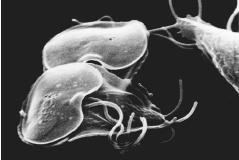|
This section contains 476 words (approx. 2 pages at 300 words per page) |

|
 Giardia. (Photograph by J. Paulin. Visuals Unlimited. Reproduced by permission.)
Giardia. (Photograph by J. Paulin. Visuals Unlimited. Reproduced by permission.)
Giardia is the genus (and common) name of a protozoan parasite in the phylum Sarcomastigophora. It was first described in 1681 by Antoni van Leeuwenhoek (called "The Father of Microbiology"), who discovered it in his own stool. The most common species is Giardia intestinalis (also called lamblia), which is a fairly common parasite found in humans. The disease it causes is called giardiasis.
The trophozoite (feeding) stage is easily recognized by its pear-shaped, bilaterally-symmetrical form with two internal nuclei and four pairs of external flagella; the thin-walled cyst (infective) stage is oval. Both stages are found in the upper part of the small intestine in the mucosal lining. The anterior region of the ventral surface of the troph stage is modified into a sucking disc used to attach to the host's abdominal epithelial tissue. Each troph attaches to one...
|
This section contains 476 words (approx. 2 pages at 300 words per page) |

|


